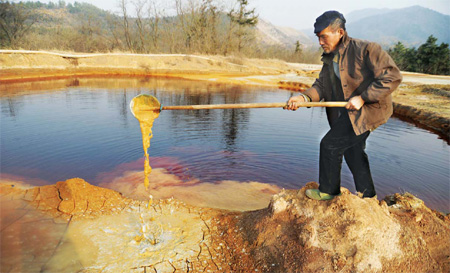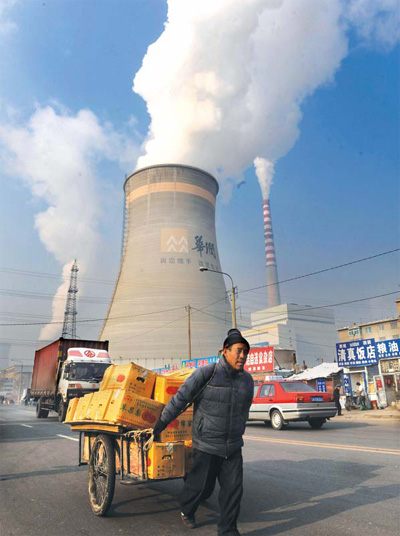Focus
A hard rain is falling as acid erodes beauty
By Li Jing in Beijing and Peng Yining in Xiamen (China Daily)
Updated: 2011-01-12 07:59
 |
Large Medium Small |
|
|
Cities tackle problem. Li Jing in Beijing and Peng Yining in Xiamen report.
With its tranquil scenic beauty, Xiamen has long been regarded one of the best places to live or visit in China. The city, which lies in the southeastern part of Fujian province, boasts coastal vistas, unique architecture and a rich history dating back centuries.
Yet, this popular tourist hotspot is in danger of losing its sparkle, as acid rain continues to stain its colonial-era buildings, particularly on the famed islet of Gulangyu.
Official statistics show every drop of rain in Xiamen in the first half of 2010 was acidic, recording pH levels of less than 5.6 (neutral is 7).
"The acid rain is leaving buildings with yellowish signs of corrosion ... and is slowly turning the leafy island yellow," said Zhuang Mazhan, chief engineer at Xiamen's Environmental Monitoring Central Station. "It's making the city much less attractive."
Xiamen is not the only victim. Leshan Giant Buddha, which has stood in Southwest China for more than 1,000 years, has also been badly affected. Its nose is turning black, hair curls have fallen from its head and its reddish body is becoming a charred gray color.
At 71 meters high and 28 meters wide, the Buddhist statue in Sichuan province is the largest of its kind in the world. Since being carved out of a cliff during the Tang Dynasty (AD 618-907), the relic has survived floods and earthquakes, but it is now at great risk from a man-made threat.
Acid rain is a by-product of burning coal and fossil fuels. Combustion releases sulfur dioxide (SO2) and nitrogen oxides (both nitric oxide and nitrogen dioxide) into the air, which bond with water and oxygen molecules and then fall as sulfuric and nitric acid.
As the world's largest coal consumer, China is also the third largest acid rain region, after Europe and North America. A 2005 report found that 28 percent of the country's territory, mostly south of the Yangtze River, was affected by acid rain.
In 2005, Chinese factories spewed out 25.5 million tons of SO2, double the level regarded as "safe", according to the country's environmental authorities. The findings prompted the central government to adopt an aggressive target to rein in the rapid increase of SO2 emissions from unbridled industrial development. The aim was to reduce the discharge of the pollutant by 10 percent by the end of 2010.
Through phasing out inefficient thermal power-generating units and installing scrubbers (chemical filters fitted in chimneys) to remove pollutants, China achieved a 14-percent drop in SO2 emission between 2006 and 2010, from 2005 levels, said Zhou Shengxian, minister of environmental protection.
However, as China claimed victory in meeting its 10-percent sulfur reduction target, monitoring results showed acid rain is still battering many parts of the country, with increased frequency in some areas.
According to the latest annual quality report published by the Ministry of Environmental Protection, 258 cities and counties recorded acid rainfall in 2009. For 112 of them, at least one in every two precipitations was acidic.
In fact, the areas suffering from acid rain are actually expanding, with some already reporting increased acidity, an internal study commissioned by the ministry and led by Tsinghua University has discovered.
Monitoring stations in the Pan-Bohai Bay area in Northeast China, for example, have recorded the highest frequency and acidity of acid rain in 15 years, states the study report.
The coastal city of Dalian in Liaoning province, also a popular summer resort, reported an acid rain frequency of 51.6 percent in 2007.
Acid rainfall is also increasing along the west coast of the Taiwan Straits, around Chengdu and Chongqing in Southwest China and throughout the Pan-Beibu Gulf Economic Zone in the south. All these regions are expected to become the country's next growth engines thanks to booming heavy industries, such as petrochemicals, energy, metallurgy and equipment manufacturing, according to the Tsinghua-led study.
Cutting emissions
The sad findings of that report suggest the country has failed to curb environmental deterioration despite huge anti-pollution efforts, said Wei Fusheng, an academician at the Chinese Academy of Engineering.
His comments echo the growing public complaints about worsening air quality in many major cities.
Last month, Beijing's municipal government announced it had hit its target of 266 "blue-sky days" in 2010 ahead of schedule. However, the usual thick smog and the smell of smoke during winter - when the central heating system is fired up - made some citizens doubt the accuracy of the capital's air quality ratings. Similarly, in the Yangtze River and Pearl River deltas, more hazy days are recorded every year.
"That shows the existing monitoring and assessment systems for the country's environmental quality have their defects," said Wei, who added that, for one thing, nitrogen oxides and other pollutants are still left out when it comes to emissions control.
Nitric oxide (NO) is mainly derived from road transport emissions and combustion processes, such as the electricity-generating sector. It can rapidly be oxidized to nitrogen dioxide (NO2) once released to the atmosphere. Together, they are referred to as nitrogen oxides (NOx).
NO2 can irritate the lungs and lower people's resistance to respiratory infections, like influenza. Continued exposure to higher concentrations can also cause increased incidence of acute respiratory illness in children. "It is impossible to cure haze and acid rain problems in large cities without addressing pollution with nitrogen oxides," said Yang Jintian, deputy chief engineer at the Chinese Academy of Environmental Planning.
In China, coal-fired power plants are major sources of nitrogen oxides and contribute 45.5 percent to total emissions. In 2008, emissions reached 20 million tons, the largest in the world, said Yang.
As the world's biggest automaker and consumer of automobiles since 2009, China's vehicle exhaust fumes are major contributors to air pollution.
A joint study by scientists from Tsinghua University, Harvard University and the Norwegian Institute for Water Research, which was published in the American Chemical Society's Environmental Science and Technology journal in 2009, concluded that the benefits of SO2 reductions in China can be offset by increased nitrogen emissions in a few years, if the country does not adopt a multi-pollutant control strategy that integrates measures to reduce sulfur, nitrogen and particulate matter.
Daunting challenges
Environmental authorities announced that in the upcoming 12th Five-Year Plan (2011-2015), China will include two more pollutants - nitrogen oxides and ammonia nitrogen, which leads to excessive nutrients and causes algae outbreaks in water - under its mandatory pollution-control program.
The new target proposed by the Ministry of Environmental Protection is to slash both pollutants by 10 percent in the next five years.
For sulfur dioxide and chemical oxygen demand, which is a measurement of water pollution, the new reduction goals will be set at about 8 percent, slightly lower than the 10-percent target between 2006 and 2010, according to a source with the Ministry of Environmental Protection who did not want to be identified discussing policy that has not yet been approved.
The proposal is still awaiting clearance from the State Council, with a final decision expected in March during the annual two sessions of the National People's Congress and the Chinese People's Political Consultative Conference.
The ministry official admitted China will face even more pressure to achieve its air pollution control targets, considering its expanding appetite for coal consumption.
Tao Wang, an atmospheric chemist at Hong Kong Polytechnic University, said nitrogen emissions are more difficult to curtail than sulfur. Whereas sulfur-scrubbing technology can reduce emissions at power plants by about 90 percent, nitrogen-control technologies such as low-NOx burners typically only achieve 10 to 60 percent efficiency, he explained.
Technologies that can produce 85- to 90-percent reductions in NOx are available, but they are still too expensive and not yet widely used in China.
Bosses at several power plants visited by China Daily reporters complained the original designs of their facilities do not allow physical space to install new equipment. To meet the new pollution control targets will require them to completely revamp their plants.
It will be even more difficult to deal with the nitrogen emissions from vehicles, which remain a worldwide challenge.
There is already little room left for China to further slash sulfur emissions, said the ministry source. By the end of 2009, about 71 percent of coal-fired power plants had been equipped with sulfur scrubbers, compared to 12 percent back in 2005. "The next step is to take a closer look at whether these facilities are actually put into use," he said.
The ministry official admitted the biggest challenge remains China's enormous coal consumption, which is set to grow at a relatively high rate during the coming years to fuel the country's economic growth. "Studies by some experts have suggested that burning 3 billion tons of coal every year would be the upper limit if we want to keep the sulfur and nitrogen emissions to a reasonable level," he added.
Despite the central government's pledge to rely more on renewable energy sources, Wang Xianzheng, president of the China National Coal Association, recently projected annual coal consumption will reach 3.8 billion tons by 2015, an increase of 800 million tons compared to 2009.
Zhang Xiaomin in Dalian contributed to this story.
|
|


